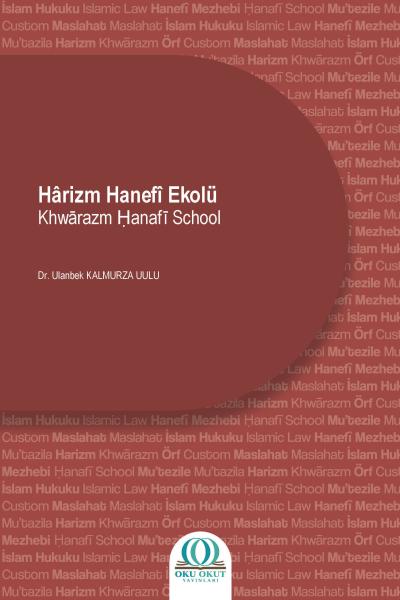Oku Okut Press reserves the right to publish and distribute the book. Permission from the publisher is required for any commercial use.
Authors
-
Dr. Ulanbek Kalmurza Uuluhttps://orcid.org/0000-0002-8492-8142
This study focuses on the Ḥanafī school of jurisprudence that emerged in the Khwārazm region during the 5th to 7th centuries AH, aiming to determine its place within the broader Ḥanafī legal tradition. Within the scope of this study, the historical period starting with Abū ʿImrān al-Baqqālī (d. 452/1060), regarded as the pioneer of the Khwārazmian legal school, and culminating with one of its prominent figures, Abū ’l-Rajāʾ al-Zāhidī (d. 658/1260), has been examined. The geographical, socio-cultural, customary, and political background influencing the formation of the Khwārazm school of law has been analyzed in detail. The theological background that played a role in shaping this school has also been discussed. To this end, the motivations and intellectual foundations behind the emergence of the Khwārazm legal school have been explored, and a comparative evaluation has been conducted with the legal traditions of Khurāsān, Samarqand, Bukhara, and Balkh. The study adopts a historical analysis and textual interpretation methodology. In the textual analysis, sub-methods such as literature review, document analysis, induction, evaluation of field data, and comparative interpretation have been employed. As a result of the research, it has been observed that the Khwārazm school was largely nourished by the Ḥanafī tradition of Iraq in the fields of kalām and uṣūl al-fiqh, and that it interacted with the views of scholars from these circles. However, considering the unique geographical, historical, and socio-cultural dynamics of Khwārazm, the school gradually underwent an original transformation, acquiring certain features that distinguished it from classical Iraqi Ḥanafism. One of the distinguishing features of this school was its active engagement with kalām and its adoption of the Muʿtazilite theological framework. Nevertheless, this Muʿtazilite thought evolved over time in response to the intellectual and social conditions of the region, giving rise to a local and distinctive identity distinct from the classical Baghdad Muʿtazilism. This Muʿtazilite tendency in Khwārazm eventually took on the character of a “Sunnī-leaning Muʿtazilite thought” or a “Muʿtazilite thought closely aligned with Ahl al-Sunnah”. Additionally, it has been found that members of this school adopted the method of istiḥsān and the principle of taysīr, grounded in custom and public interest, applying these principles in judicial rulings and fatwās.
Bu çalışma hicrî 5.-7. yüzyıllar arasında Hârizm bölgesinde teşekkül eden Hanefî fıkıh okulunu ve bu okulun Hanefî mezhebi havzaları içinde nereye oturduğunun tespitini konu edinmektedir. Konunun sınırlandırılması bağlamında söz konusu fıkıh okulunun öncüsü olarak kabul edilen Ebû Imrân el-Bakkālî’den (öl. 452/1060) başlayarak zirve temsilcilerinden Ebü’r-Recâ ez-Zâhidî (öl. 658/1260) ile son bulan tarihsel süreç ele alınmıştır. Çalışmada Hârizm fıkıh mektebinin oluşumuna etki eden coğrafi, sosyo-kültürel, örfî ve siyasî arka plan ayrıntılı biçimde incelenmiştir. Ayrıca bu okulun şekillenmesinde etkin olan kelâmî arka planı ele alınmıştır. Bu amaçla Hârizm fıkıh mektebinin ortaya çıkışındaki saikler ve entelektüel zemin araştırılmış; bu bağlamda Horasan, Semerkant, Buhara ve Belh fıkıh okullarıyla mukayeseli bir değerlendirme yapılmıştır. Yöntem olarak tarihsel analiz ve metin çözümlemesi benimsenmiştir. Metin analizinde ise literatür taraması, belge incelemesi, tümevarım, saha verilerinin değerlendirilmesi ve mukayeseli yorumlama gibi alt tekniklerden faydalanılmıştır. Araştırma neticesinde Hârizm fıkıh okulunun kelâm ve usûl-i fıkıh alanlarında büyük ölçüde Irak Hanefîliğinden beslendiği ve bu çevreye mensup âlimlerin görüşleri ile etkileşim içinde olduğu müşahede edilmiştir. Bununla birlikte Hârizm’in kendine özgü coğrafi, tarihî ve sosyo-kültürel dinamikleri dikkate alındığında bu mektebin zamanla özgün bir dönüşüm geçirdiği ve klasik Irak Hanefîliğinden ayrışan bazı özellikler kazandığı görülmüştür. Bu okulun ayırt edici yönlerinden biri olarak kelâm ilminin etkin şekilde kullanılması ve kelâmî eğilim olarak Mu‘tezile ekolünün benimsenmesi tespit edilmiştir. Ancak bu Mu‘tezilî düşünce, zaman içinde bölgenin ilmî ve sosyal şartlarına bağlı olarak evrilmiş ve klasik Bağdat Mu‘tezilesi'nden farklı, yerel ve özgün bir kimlik kazanmış ve Hârizm’deki bu Mu‘tezilî eğilim belirgin şekilde “Sünnî eğilimli Mu‘tezilî düşünce” ya da “Ehl-i Sünnet’e yakın duran bir Mu‘tezilî düşünce” karakterine dönüşmüştür. Ayrıca bu okulun mensuplarının örf ve maslahata dayalı istihsan yöntemini ve kolaylık ilkesini benimsedikleri, bunu kazâ ve fetvâ alanında ortaya koydukları da görülmüştür.
Copyright
Copyright (c) 2025 Oku Okut Press
ePub License

This work is licensed under a Creative Commons Attribution-NonCommercial 4.0 International License.
Author Biography
-
Dr. Ulanbek Kalmurza Uulu, Kyrgyz-Turkish Manas University
Ulanbek Kalmurza Uulu completed his secondary education at No. 36 Madaniyat High School. He graduated in 2017 from the Faculty of Theology at Kyrgyz-Turkish Manas University with a double major in Islamic Studies and Religious Studies. In the same year, he was admitted to the Master's program at the Graduate School of Social Sciences of Kyrgyz-Turkish Manas University, which he completed in 2020. He completed his doctoral studies in 2025 with a dissertation titled “The Khwārazm Ḥanafī School”. Since his graduation, he has been working as a research assistant in the Department of Islamic Studies at the Faculty of Theology, Kyrgyz-Turkish Manas University. He is fluent in Arabic and Russian, and has intermediate proficiency in English. His primary academic interests include Islamic jurisprudence (fiqh), the principles of jurisprudence (usūl al-fiqh), and Islamic theology (kalām).
Downloads
Publication Information
-
Publication TypeMonograph
-
Published22 July 2025
-
Series
-
Series Position1
-
Categories
-
ISBN-10 (02)625-95679-4-5
-
ISBN-13 (15)978-625-95679-4-5
-
Publication date (01)07/22/2025
Details about this monograph
The data used in this study have been classified, analyzed, and reported in accordance with scientific and ethical standards. The data will not be shared with third parties or institutions.
Kalmurza Uulu, Ulanbek. Khwārazm Ḥanafī School. critical ed . Ankara: Oku Okut Press, 2025. https://doi.org/10.55709/okuokutyayinlari.77












